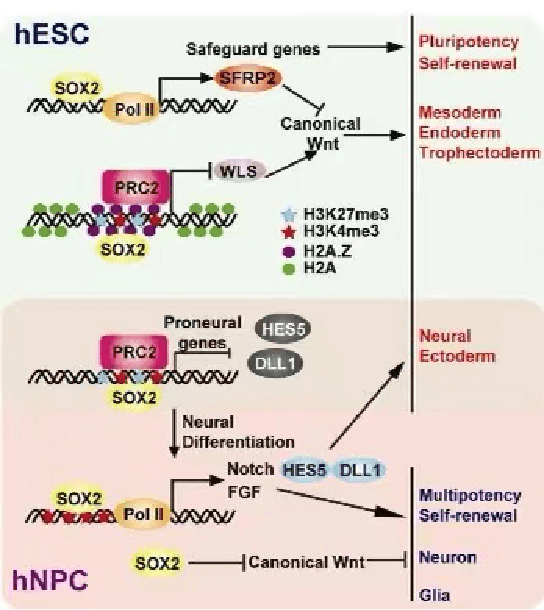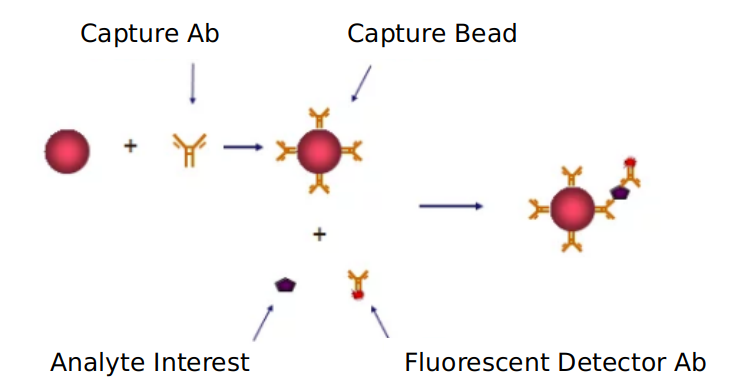Introduction to sox-2 signaling pathway
Based on Luminex technology platform, Creative Proteomics provides analysis services for key targets of sox-2 signaling pathway.
 The Sox gene family encodes a set of transcription factors that are evolutionarily conserved and structurally highly related to SRY (Y chromosome sex determining region), which regulates important life events such as early embryonic development, neural differentiation, sex orientation, and cell growth. At present, more than 20 sox family members have been discovered and named internationally. Sox-2 belongs to the Sox gene family B group B1 subgroup. It is located at 3q36.3-27. It is a single exon structure, which encodes and expresses 317 amino acid residues. The protein sox-2 is very important for the early development and maintenance of undifferentiated embryonic stem cells. sox is one of the key transcription factors originally used to obtain inducible pluripotent cells from fibroblasts, and sox-2 Gene overexpression or gene amplification is associated with the development of many cancers.
The Sox gene family encodes a set of transcription factors that are evolutionarily conserved and structurally highly related to SRY (Y chromosome sex determining region), which regulates important life events such as early embryonic development, neural differentiation, sex orientation, and cell growth. At present, more than 20 sox family members have been discovered and named internationally. Sox-2 belongs to the Sox gene family B group B1 subgroup. It is located at 3q36.3-27. It is a single exon structure, which encodes and expresses 317 amino acid residues. The protein sox-2 is very important for the early development and maintenance of undifferentiated embryonic stem cells. sox is one of the key transcription factors originally used to obtain inducible pluripotent cells from fibroblasts, and sox-2 Gene overexpression or gene amplification is associated with the development of many cancers.
In the complex signaling pathway network, the expression and activity of sox-2 are regulated by its upstream signal molecules. While being regulated by upstream molecules, sox-2 regulates the expression and activity of a large number of downstream molecules in the development of cells and tumors. Play its important role in the signal network.
In the transduction pathway network, sox-2 not only regulates the expression of related genes by directly binding to DNA targets, but also forms complexes with other proteins to affect cell DNA processing, chromatin assembly, RNA processing and other activities. In some studies, most of the protein identification techniques are used to identify many proteins that interact with sox-2 in biological processes, and it is found that multiple proteins can form complexes with sox-2 at different sites at the same time. The complex formed by sox-2 and other proteins also plays a major role in the regulation of the signal transduction pathway network.
As an important transcription factor for maintaining stem cells, the sox-2 signal pathway participates in a complex network of cellular signal transduction pathways. It is used in cell biology through signal transduction with upstream and downstream molecules and interactions with some proteins. Play a role in the process. sox-2 itself is regulated by various factors in transcription, translation and post-translational levels. Eventually becomes active sox-2 protein. With the reveal of the deep-seated mechanism of sox-2 affecting the biological behavior of tumors, Sox2 and its upstream and downstream molecules in the transduction pathway network and proteins that interact with sox-2 are expected to become new targets in cancer treatment and bring about tumor treatment. Milestone progress.
Our detectable targets:
| STAT5 | IRAK4 | JNK | MYD88 | Rac1 | TLR4 |
| CREB | IRF3 | MAPK | NAP1 | Rel | TLR9 |
| TCR | icam1 | Mda-5 | NFκB | RIG-1 | TRAF3 |
| GAS | IRF9 | MEKK1 | p38 | RIP1 | TRAF5 |
| CD3 | IRF5 | MEK3 | p38MAPK | SH2 | TRAF6 |
| MHC-II | IRS1 | MEK6 | p50 | SLP76 | TRAM |
| PSGL1 | IRS2 | MSK1 | TLR3 | Tak1 | TRIF |
| TNFR | ISGF3 | MSK2 | PI3K | TBK1 | Vav |
| Fas | ISRE | mTOR | PKR |
Technology platform:
We provide Luminex technology for sox-2 signaling pathway analysis.
Luminex technology is a multifunctional liquid phase analysis platform developed on the basis of colored microspheres, laser technology, applied fluidics and high-speed digital signal processing technology. The core is to encode polypropylene microspheres or magnetic microspheres with fluorescent dyes. By adjusting the different ratios of the two fluorescent dyes, up to 100 microspheres with different fluorescence spectra can be obtained. Antigen-antibody, enzyme-substrate, ligand-receptor binding reactions and nucleic acid hybridization reactions are performed on microspheres with different fluorescence encoding. Qualitative and quantitative analysis by laser detection of microsphere coding and reporter fluorescence separately.
Sox-2 is one of the key transcription factors originally used to obtain induced pluripotent stem cells from fibroblasts. It plays an important role in the regulation of signal transduction pathway network.
In addition to Luminex Multiplex Assay, Enzyme-linked immunosorbent assay (ELISA), Flow cytometry (FACS analysis) technology can also be provided to meet other customer needs.
Advantages of sox-2 signaling pathway detection:
- High-throughput: Simultaneous analysis of multiple target molecules in the same sample. Theoretically, the detection flux is equal to the number of types of microspheres, that is, up to 100 types.
- Low sample consumption: Because 100 different target molecules can be detected in the same reaction well at the same time, the amount of sample is greatly saved; and because of the small size of the microspheres, as little as 1 puL of samples can be detected.
- Simple and fast operation: Because it is a liquid phase system, the reaction time is greatly shortened, and multiple cytokine detection can be completed within 2 to 3 hours.

Application of our service:
- To study the regulation mechanism of sox-2 signal pathway in disease
- To study the effect of each virus on sox-2 signaling pathway
- To study the effects of drugs or therapies on sox-2 signaling pathways
Creative Proteomics has developed a signal pathway target detection platform. We are not limited to providing sox-2 signal path detection services, but can also provide other signal path detection services. If you want to detect other targets, please contact us and we will customize the service for you. Look forward to working with you.
References:
- Zhan Y, Li R, et al. Chlorogenic acid inhibits esophageal squamous cell carcinoma growth in vitro and in vivo by downregulating the expression of BMI1 and SOX2. Biomed Pharmacother, 2020, 121.
- PACKARD A, Lin B, et al. Sox2 and Pax6 Play Counteracting Roles in Regulating Neurogenesis within the Murine Olfactory Epithelium. PLoS ONE, 2016, 11.



